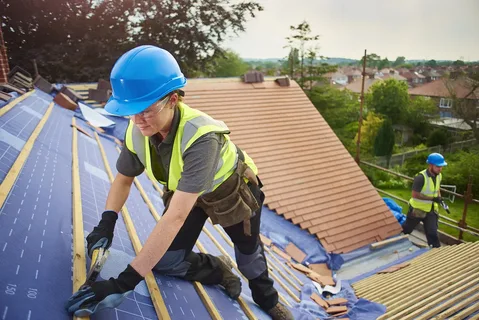Have you ever been caught in the middle of a storm only to notice water dripping from your ceiling?
That sinking feeling when rain pours inside is something every homeowner dreads.
At that moment, searching roof tarping near me becomes urgent. The damage can spread fast, but there is a simple short-term fix that saves your home until permanent repairs are complete.
Understanding Roof Tarping in Emergencies
When shingles blow away or tree limbs puncture your roof, water enters quickly. That is when roof tarping works as the first shield. Homeowners who type “ roof tarping near me” are not looking for DIY hacks; they want trusted professionals ready at any hour.
A properly installed tarp keeps moisture out, prevents mold, and buys time for roof leak repair or replacement. Insurance roof claims often require proof that you took steps to stop further damage. Emergency tarping does exactly that. It protects your house and supports your claim process.
Factors That Affect Roof Tarping Costs
Roof Size and Area
The larger your roof, the higher the cost. Most roof tarps (including both labor and materials) cost about $2–$5 per square foot. Bigger roofs need more tarp, more fasteners, and more time to install, which adds to the total price. Things like roof slope, height, tarp thickness, and how the tarp is applied can also affect costs. To get the most accurate estimate, you need to know your roof’s square footage before asking for quotes.
Roof Shape and Design
Simple roofs are faster and cheaper to cover. But if your roof has steep slopes, chimneys, dormers, or multiple ridges, installation takes more work. Roofers may need to cut and adjust the tarp carefully to fit around these features. Flat roofs may sound easier, but they come with their own challenges, like preventing water from pooling during heavy rain.
Tarp Material and Quality
Not all tarps are the same. Thinner tarps (about 5–6 mils) are cheaper and work well for short-term fixes. Heavy-duty tarps (15–25 mils) are stronger and last longer, especially in tough weather. However, thicker tarps can cost up to three times more. Choosing the right type depends on how long you need coverage and the local weather conditions. If you’re unsure, roofing contractors can guide you when giving quotes.
Labor and Accessibility
Professional roofing contractors usually charge between $300–$400 per hour. Costs can go up if your roof is hard to reach, very steep, or surrounded by obstacles like trees or landscaping. In these cases, roofers may need special ladders, scaffolding, or safety gear, which increases labor costs.
Types of Roof Tarps and Their Costs
Poly Tarpaulin
A good all-purpose option is lightweight, waterproof, tear-resistant, and budget-friendly. Ideal for quick temporary fixes in mild to moderate weather.
Canvas Tarps
Breathable yet moisture-resistant, canvas tarps work well in humid areas and offer a balance between cost and durability.
Vinyl Tarps
Tough, waterproof, and mildew-resistant, vinyl tarps are great for long-term protection. They cost more but last longer in harsh weather.
Mesh Tarps
It is not fully waterproof, but it is affordable and lightweight. Useful for airflow, pest protection, or temporary coverage in construction areas where full water protection isn’t needed.
Why Speed Matters in Central Florida
Central Florida faces heavy rains and seasonal storms. Once water intrudes, drywall softens, insulation absorbs moisture, and electrical systems become unsafe. That is why a fast search like roof tarping near me is not about convenience; it is about preventing a chain reaction of costly repairs.
Roof leak repair services confirm that most interior damage occurs within hours. Acting quickly is the difference between replacing a ceiling panel and rebuilding entire rooms.
Professional vs. DIY Tarping
Trying to tarp your roof alone sounds like a quick fix. In reality, it is unsafe and rarely effective. Wet shingles, steep slopes, and strong winds make it risky. A trained crew arrives with safety gear, heavy tarps, and tools to secure everything against further storms.
| DIY Attempt | Professional Service |
| Unsafe climbing | Trained with a safety harness |
| Cheap plastic sheets | Heavy-duty tarps |
| Poor sealing | Fully secured edges |
| Short-term fix | Lasts until permanent repair |
How Roof Tarping Fits into Long-Term Repair
A tarp is not the final answer. It is step one. After stabilization comes inspection, roof leak repair, or sometimes full replacement. Homeowners gain breathing room to make the right choice without rushing into a contract under stress.
The Insurance Connection
Homeowners often worry about cost. Good news: most storm damage roof repair expenses are linked to insurance coverage. Insurers expect you to act fast. Delays can result in denied claims. Emergency tarping proves you took action. Professional roofers document everything with photos and reports so you have a stronger file.
24/7 Service: Why Availability Matters
Storms do not wait for office hours. The best roofing contractors in Central Florida keep lines open around the clock. Whether it is midnight rain or early morning winds, a call brings help within hours.
Conclusion
If your roof fails during a storm, your first thought should be to search for roof tarping near me. Fast action saves thousands in damage, strengthens your insurance claim, and keeps your home safe until repairs finish. In Central Florida, the weather is unpredictable, but your response does not have to be.



